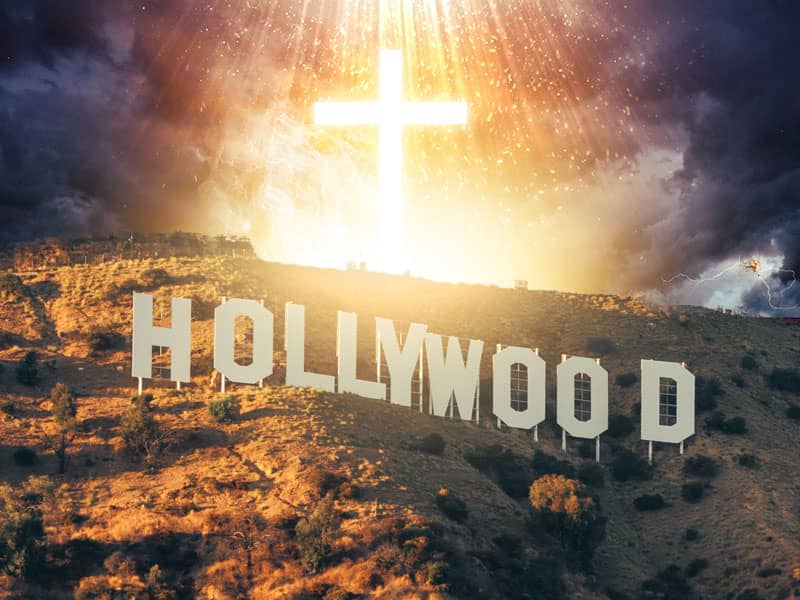1912 This film was produced by the Lem Company in 1912, one of the leading American production companies of the era. Remarkably, it was filmed on location in Egypt and Palestine and it exhibits high production value for its time. The title of the film accurately describes the framework within which the story of Jesus is told, from manger to cross, from birth to death. With only snippets of gospel text to explain what appears on the screen, the viewer must have prior familiarity with the Jesus story to fully appreciate many of the incidental moments on the screen that are not explained in writing. What has become known in our day of television and cablevision as the "electronic church" as its origins in these turn-of-the-century occasions when film was used to communicate a Christian message. The New York Dramatic Mirror evaluated the film primarily in terms of its cinematic qualities and commended it for its "general artistic excellence" with the exception of the visual awkwardness of the walking on the water scene.
That the film eventually found public acceptance is supported by the fact that it was periodically reissued.
1916 Filmed in Hollywood at the Fine Arts Studio on Sunset Boulevard in 1916,D.W. Griffith underscored the theme of the film's title by telling not one but four stories from different periods: a Modern story of a young man in the United States sentenced to die for a murder he did not commit, a French story of the St.Bartholomew's Day massacre of Huguernots by Catholics in 1572, a Judean story of the crucifixion of Jesus set, in the first century, and a Babylonian story of the fall of the city of Babylon to Cyrus and the Persians in 539 BCE. Griffith daringly tells these stories cinematically by using the technique of crosscutting with the film shifting back and forth form one story to another.
"Intolerance" opened in New York City in 1916 with the musical score played by the orchestra of the Metropolitan Opera House. Both the critical and the popular response to the film have been carefully documented.
1927
The portrayal of Jesus on film received its most extravagant expression of the silent era from Cecil B. DeMille with "The Kings of Kings" in 1927. It became the most widely viewed Jesus film in the world over the next half century. The continued popularity of 'The Kings of Kings' stemmed in large measure from its reverence for the Jesus story, both off and on the screen. During the production of the film, DeMille sought the opinion of religious advisors and encouraged worship on the set.Not only was reverence shown for the Jesus story during the production process, but the completed film itself obviously caters to religious piety. The film reflects sensitivity to the kind of common piety characteristic of the United States during the first half of the twentieth century.
The critics and the public responded favorably to the film. In the U.S. it was DeMille's "The King of Kings" that remained without a serious harmonizing rival for more than thirty years.
1959 Filmed in Rome at Cinecitta Sudies in 1959 and directed by William Wyler, the debate over pacifism also surfaces in "Ben Hur". The film had an advertised cost of some fifteen million dollars. The running time of the film was nearly four hours. Upon its release, viewers were immediately greeted on the screen by something they had never seen. The trademark MGM lion, which customarily growls, was silent. The Wyler film has an appropriate subtitle: "A Tale of the Christ." This tale of Ben Hur is set in its entirety within the framework of the life of Jesus. Even before the title frames and credits, the viewers are introduced to a Christmas pageant as Mary and Joseph make their way to Bethlehem for the census and are greeted there, after the birth of their child, by shepherds (Luke) and wise men (Matt)
"Ben Hur" became the greatest success among the alternative Jesus films that subordinated the Jesus story to a tale with a Roman/Christian theme. The film represents one of the most successful films in the history of cinema. The biggest box-office draw of the decade 1951-1960 the film garnered eleven Academy Awards.
1961 For this film, producer Samuel Bronston assembled an impressive production crew. Spain became the site of production because Bronston had built enormous studios in Madrid. Although "King of Kings" incorporates many familiar stories and sayings from all four gospels into its Jesus story, these actions and words are placed in the service of a broader plot that involves expanded roles for four supporting characters in the gospels: the Roman centurion present at the cross, Barabbas, Judas the disciple, and Mary, the mother of Jesus. Bronton's film was the first commercially produced film in the United States to tell the Jesus story in the harmonizing tradition, with the camera focused throughout on the Jesus character.
The critical response to "Kings of Kings" by the secular and the religious press was devastating. Critics during the 1950's had obviously developed not only immunity from, but hostility toward, Hollywood extravaganzas with biblical subject matter. "King of Kings" bore the brunt of this hostility and ultimately became a box office failure, grossing less than its eight million dollar cost. In spite of the harsh criticism of the film, there often appeared in secular as well as religious reviews great appreciation for the persona of the Jesus character as projected by Jeffrey Hunter.

